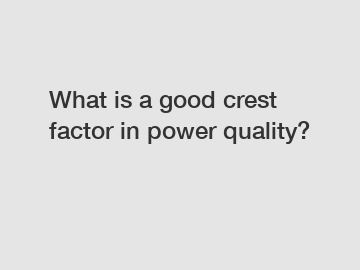What is a good crest factor in power quality?
When it comes to power quality, one of the key metrics that engineers and technicians often look at is the crest factor. But what exactly is a good crest factor, and why does it matter?
In simple terms, crest factor is a measure of the peak-to-average ratio of a waveform. It is calculated by dividing the peak value of a waveform by its RMS (root mean square) value. A high crest factor indicates that the waveform has sharp peaks and is more 'spikey', while a low crest factor indicates a smoother waveform with more consistent energy distribution.
In the context of power quality, crest factor is particularly important because it can have a significant impact on the efficiency and reliability of electrical systems. A high crest factor can lead to increased stress on equipment, higher energy losses, and even equipment failure. On the other hand, a low crest factor indicates a more stable and efficient power supply.

So, what is a good crest factor in power quality? While the ideal crest factor can vary depending on the specific application and requirements, a generally accepted guideline is a crest factor of less than 1.5. This means that the peak value of the waveform should not exceed 1.5 times the RMS value. A crest factor of 1.5 or lower is considered optimal for most industrial and commercial applications, as it indicates a relatively smooth and stable power supply.
Achieving a good crest factor requires careful design and maintenance of electrical systems, as well as the use of high-quality equipment and components. Regular testing and monitoring of power quality parameters, including crest factor, can help identify and address any issues before they lead to more serious problems.
In addition to monitoring crest factor, it is also important to consider other factors that can affect power quality, such as harmonic distortion, voltage fluctuations, and disturbances in the power supply. These factors can all contribute to an increase in crest factor and impact the overall performance of electrical systems.
To improve power quality and achieve a good crest factor, engineers and technicians can take several steps. This includes proper sizing and selection of equipment, regular maintenance and testing, and the use of power quality monitoring devices. By paying attention to these factors and taking proactive measures, organizations can ensure a reliable and efficient power supply that meets their needs.
In conclusion, crest factor is an important parameter in power quality that can have a significant impact on the performance and reliability of electrical systems. A good crest factor, typically less than 1.5, indicates a stable and efficient power supply that is less likely to cause issues with equipment and operations. By monitoring and optimizing crest factor, organizations can improve power quality and ensure a smooth and reliable supply of electricity.
If you want to learn more, please visit our website china power quality analyzer, Video Bandwidth Spectrum Analyzer, 1500 mhz signal generator.

Comments
0